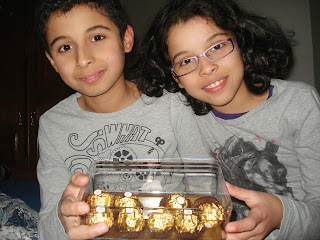I bought two chocolate bars, and a stick of my favourite brand of demi sal butter a few days ago. I chose the chocolates based on price...one mid range [blue package] and one economy [red package], rationale was I was thinking perhaps the more expensive one may have something added to preserve the shape of the bar even when exposed to warm ambient temperature. I conditioned all 3 items in the fridge for about 2 days while waiting for favorable weather.
I broke off one square of each chocolate bar...[.I picked the white and brown chocolate combinations hoping that it will show better in the pictures]and cut off a similar square of butter. Each specimen was then put separately into a small zip lock polythene bag.
 This is what the specimens looked like at 1hour exposure to ambient temperature of about 30 degrees C. Notice the butter is starting to melt a bit.
This is what the specimens looked like at 1hour exposure to ambient temperature of about 30 degrees C. Notice the butter is starting to melt a bit.  I moved the experiment to the verandah, I think the granite counter was keeping the porcelain dish cool and slowing down my experiment. This picture above is after 3 hours outside on the cement short wall of our verandah...or porch if you like....away from direct sunlight. The butter has become liquid and both chocolates have softened noticeably. I would approximate ambient temperature outside about 34 degrees C.
I moved the experiment to the verandah, I think the granite counter was keeping the porcelain dish cool and slowing down my experiment. This picture above is after 3 hours outside on the cement short wall of our verandah...or porch if you like....away from direct sunlight. The butter has become liquid and both chocolates have softened noticeably. I would approximate ambient temperature outside about 34 degrees C.  I held the bags against a white background for better visibility, the economy chocolate folded over...[far left], the butter was liquid, and the mid range chocolate[far right] shows extensive shape loss.
I held the bags against a white background for better visibility, the economy chocolate folded over...[far left], the butter was liquid, and the mid range chocolate[far right] shows extensive shape loss.
In conclusion, it may be possible to determine exposure of a package containing TTSPPs to temperature above 30 degrees C, by including into the package a small packaged piece of chocolate or butter, in a see- through polythene bag with secure closure so as not to melt onto the TTSPP. The loss of primary shape cannot be regained by subsequent cooling to desired storage temperature and so this simple supermarket products can serve as evidence of temperature excursion beyond 30degreesC.






 I
I

















.jpg)



